DYN3D and CTF Coupling within a Multiscale and Multiphysics Software Development (Part I)
Abstract
1. Introduction
2. Codes Used in the Verification
2.1. DYN3D Nodal Code
2.2. CTF Subchannel Code
3. Specifications Used in the Verification
KAIST Benchmark
4. Models and Scripts Used in the Verification
4.1. KAIST Benchmark
4.2. DYN3D and CTF Coupling Scripts
5. Results and Analysis
KAIST Benchmark
6. Conclusions
7. Future Work
8. Nomenclature
| Acronym | Full Description |
| ADF | Assembly Discontinuity Factor |
| AMR | Advanced Modular Reactor |
| ATHLET | Analysis of Thermal Hydraulics of Leaks and Transients |
| BA16 | 16 Burnable Absorber Pins |
| BEIS | Department of Business, Energy and Industrial Strategy |
| CASL | Consortium for Advanced Simulation of LWRS |
| CATHARE | Code for Analysis of Thermal Hydraulics during an Accident of Reactor and Safety Evaluation |
| CFD | Computational Fluid Dynamics |
| CTF/COBRA-TF | Coolant Boiling in Rod Arrays Two Fluid |
| CR | Control Rods |
| DNB/DNBR | Departure from Nucleate Boiling |
| DRD | Digital Reactor Design |
| DYN3D/FLOCAL | Dynamical 3 Dimensional |
| EPR | European Pressurised Reactor |
| FORTRAN | Formula Translator |
| HPC | Hinkley Point C |
| HZDR | Helmholtz Zentrum Dresden Rossendorf |
| KAIST | Korean Advanced Institute of Science and Technology |
| LOTUS | Liverpool Transport Solver |
| LWR | Light Water Reactor |
| NCSU | North Carolina State University |
| NRC | Nuclear Regulation Commission |
| NURESIM | Nuclear Reactor Simulator |
| PNL | Pacific Northwest Laboratories |
| PSU | Pennsylvania State University |
| PWR | Pressurised Water Reactor |
| RELAP5 | Reactor Excursion and Leak Analysis Program |
| SCANAIR | Systems of Codes for Analysing Reactivity Initiated Accidents |
| UK | United Kingdom |
| UOL | University of Liverpool |
| Symbol | Full Description |
| BA16 | 16 Burnable Absorber Pins |
| Clad Specific Heat | |
| Fuel Specific Heat | |
| Clad Thermal Conductivity | |
| Fuel Thermal Conductivity | |
| Fe | Iron |
| Gd2O3 | Digadolinium Trioxide |
| He | Helium |
| 235U, 238U | Uranium Isotopes |
| UO2 | Uranium Dioxide |
| Sn | Tin |
| Zr | Zirconium |
Author Contributions
Funding
Institutional Review Board Statement
Data Availability Statement
Conflicts of Interest
Appendix A. Code Types
| Code | Type | Developer |
|---|---|---|
| ORIGEN | Spectral | ORNL |
| SCALE | Spectral | ORNL |
| APOLLO2 | Lattice | Areva |
| INSILICO | Neutron Transport | UT-Batelle |
| LOTUS | Neutron Transport | UOL |
| MPACT | Neutron Transport | ORNL |
| SHIFT | Neutron Transport | ORNL |
| COBAYA3 | Nodal | UPM |
| CRONOS2 | Nodal | CEA-Saclay |
| DYN3D | Nodal | HZDR |
| ATHLET | System | GRS |
| CATHARE | System | CEA-Grenoble |
| RELAP5 | System | INL |
| CTF | Subchannel | PNL |
| FLICA4 | Subchannel | Cea-Saclay |
| SUBCHANFLOW | Subchannel | KIT |
| HYDRA-TH | CFD | INL |
| NEPTUNE | CFD | EDF |
| TRANS-AT | CFD | TRANS-AT |
| TRIO_U | CFD | IRSN |
| BISON | Fuel Performance | INL |
| DRACCAR | Fuel Performance | IRSN |
| SCANAIR | Fuel Performance | IRSN |
Appendix B. KAIST Benchmark

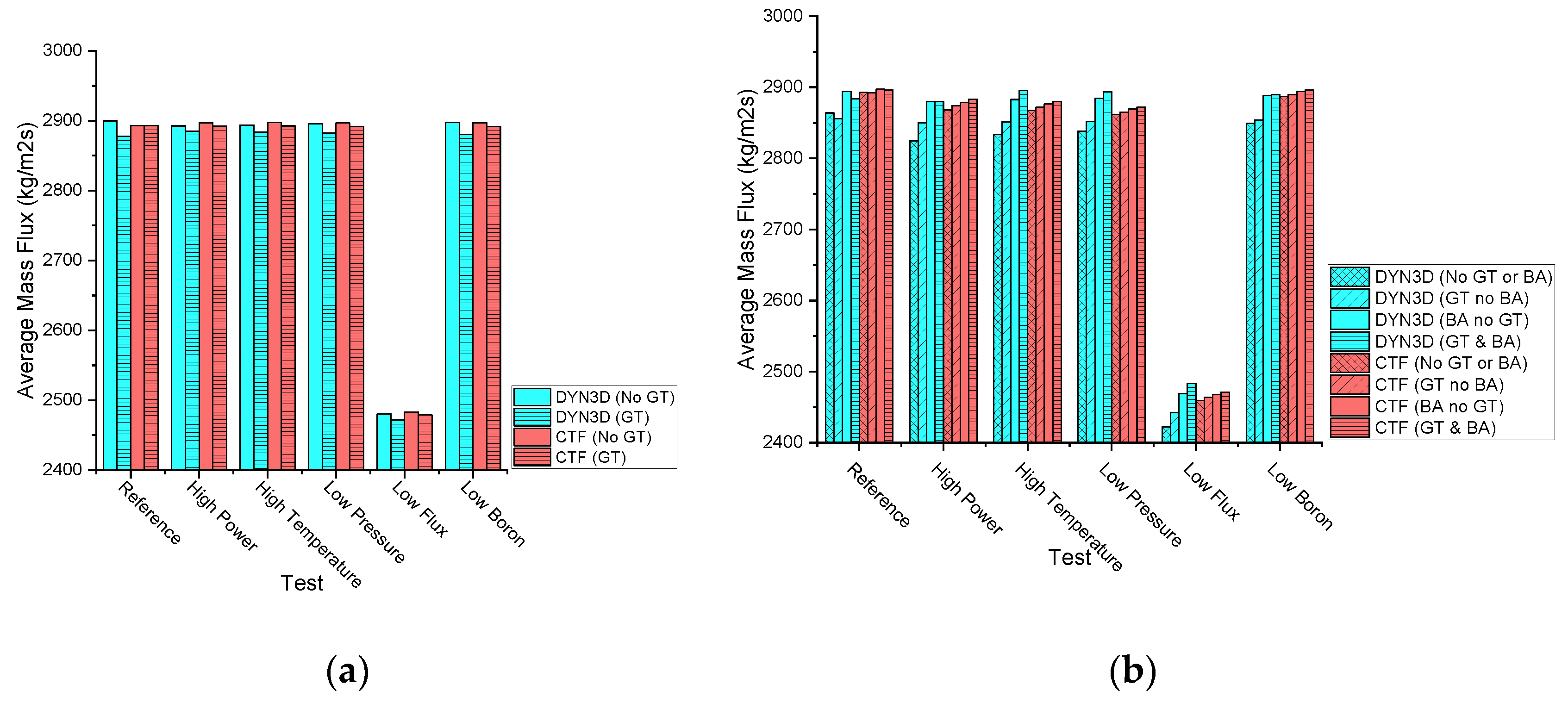


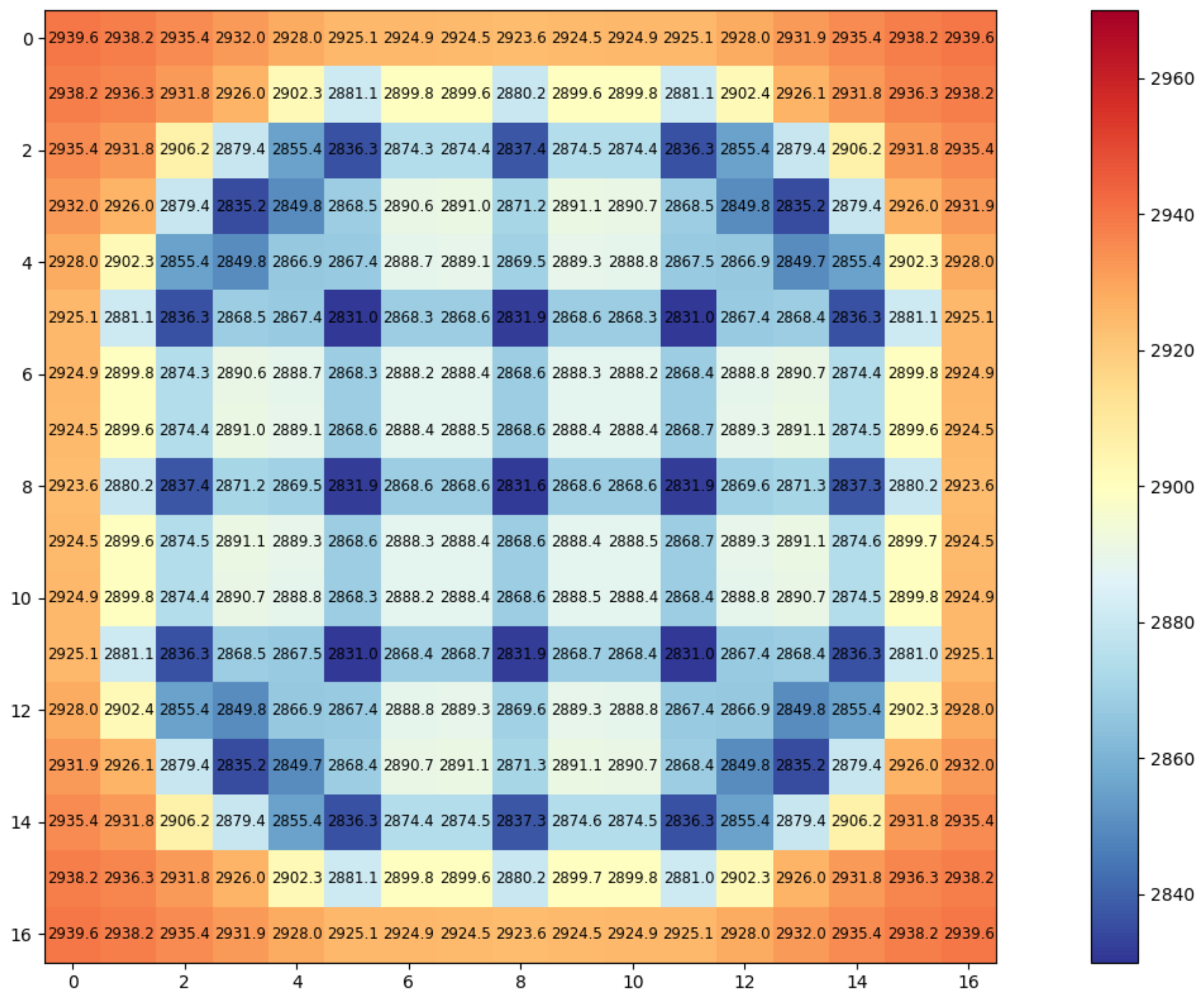
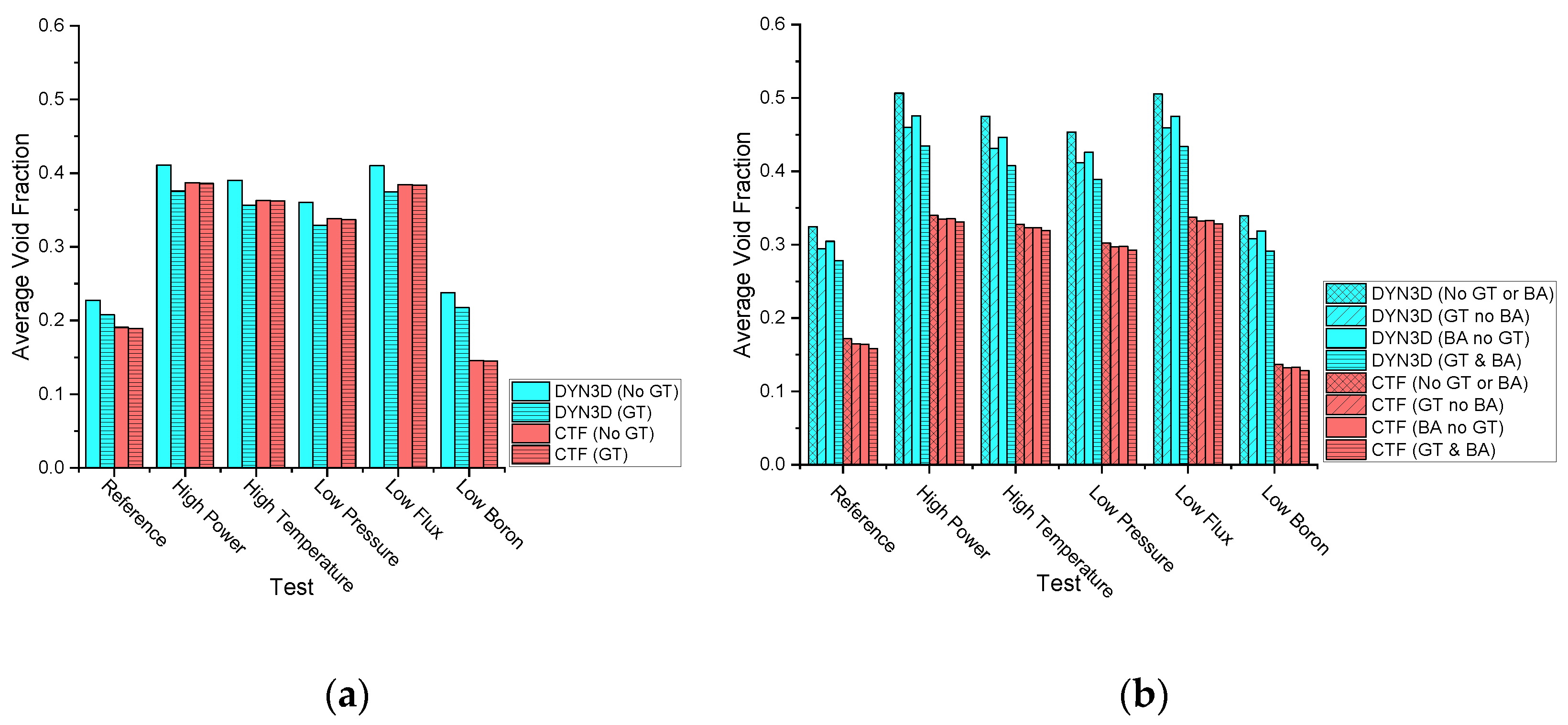
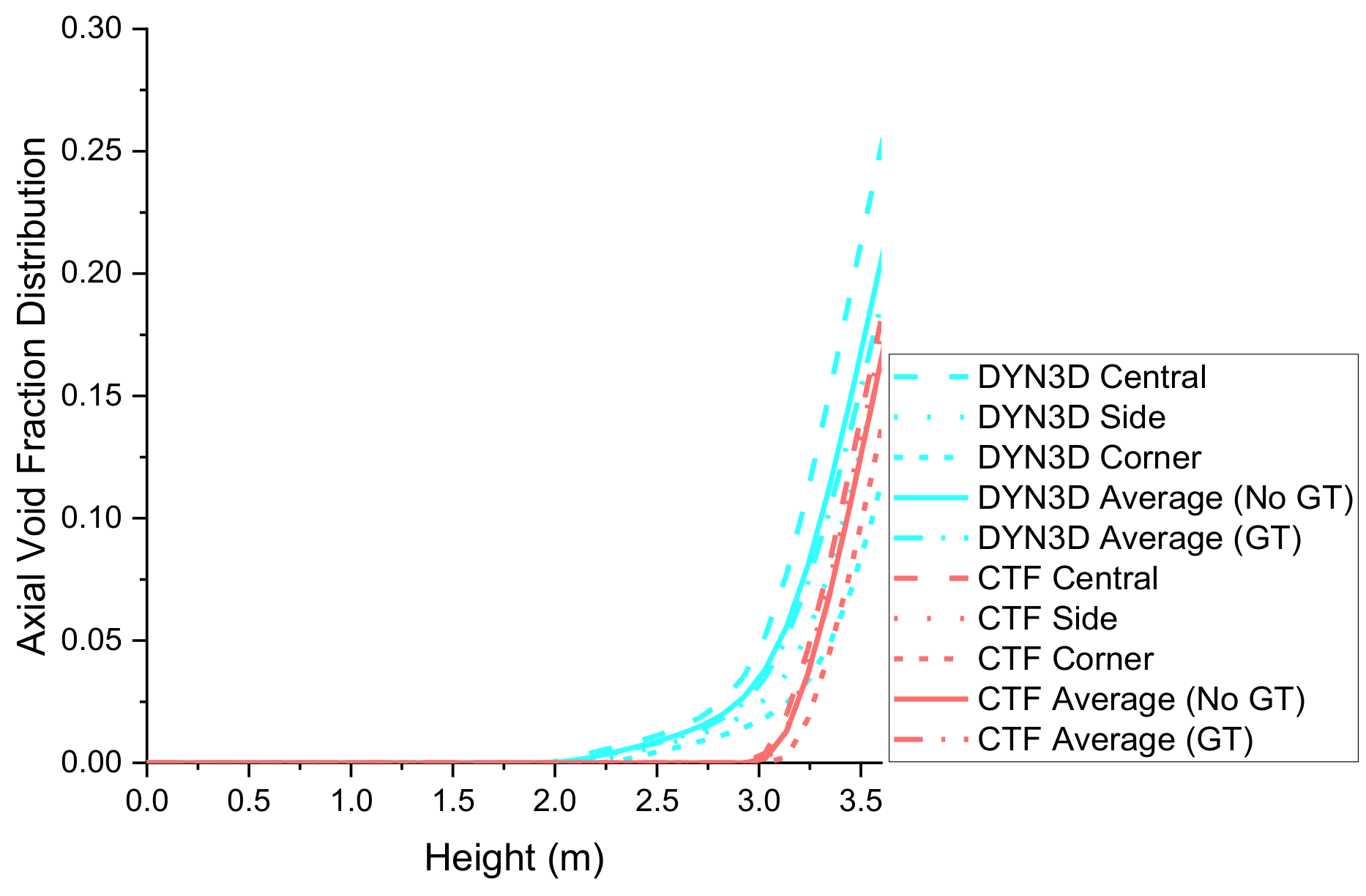
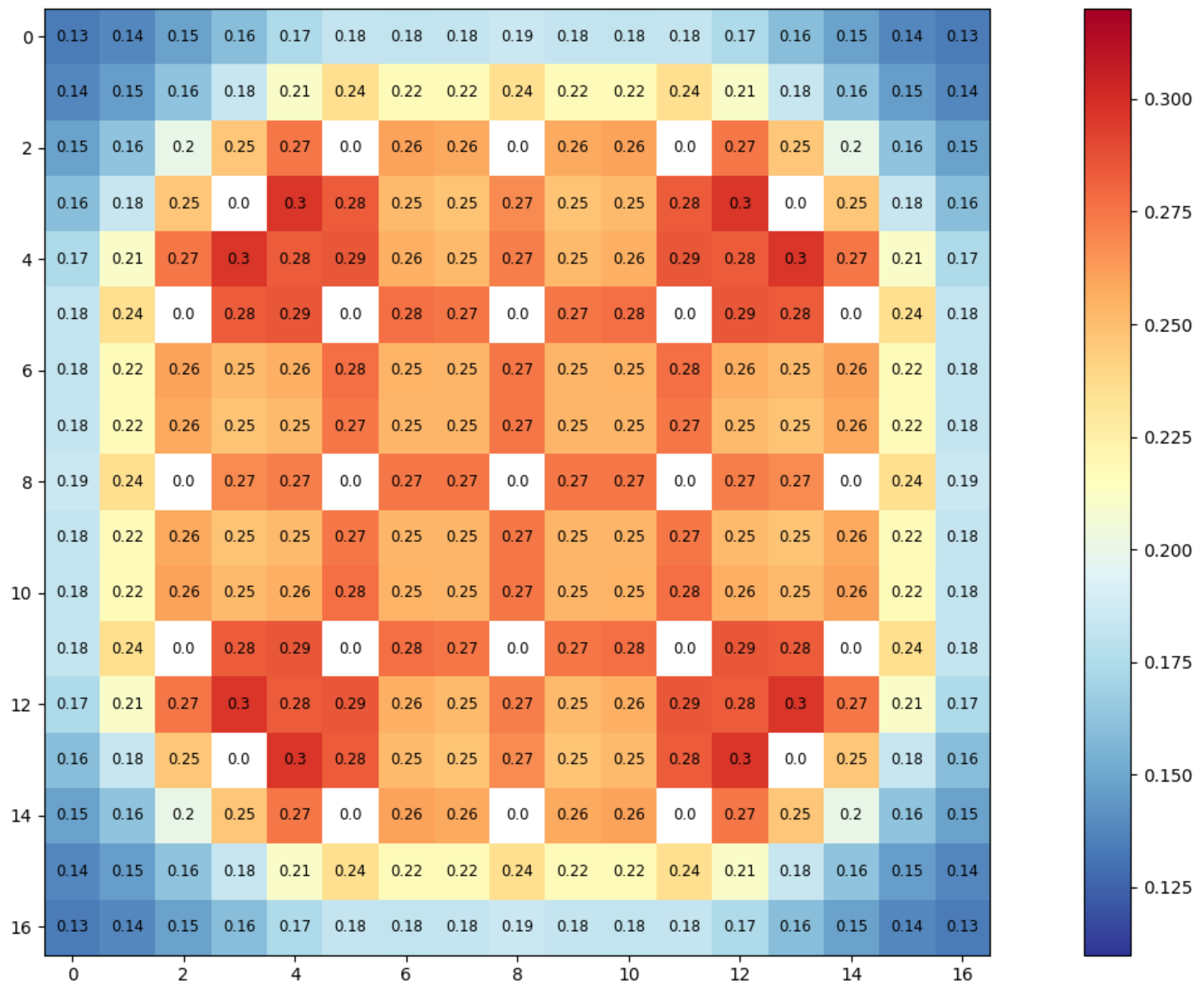
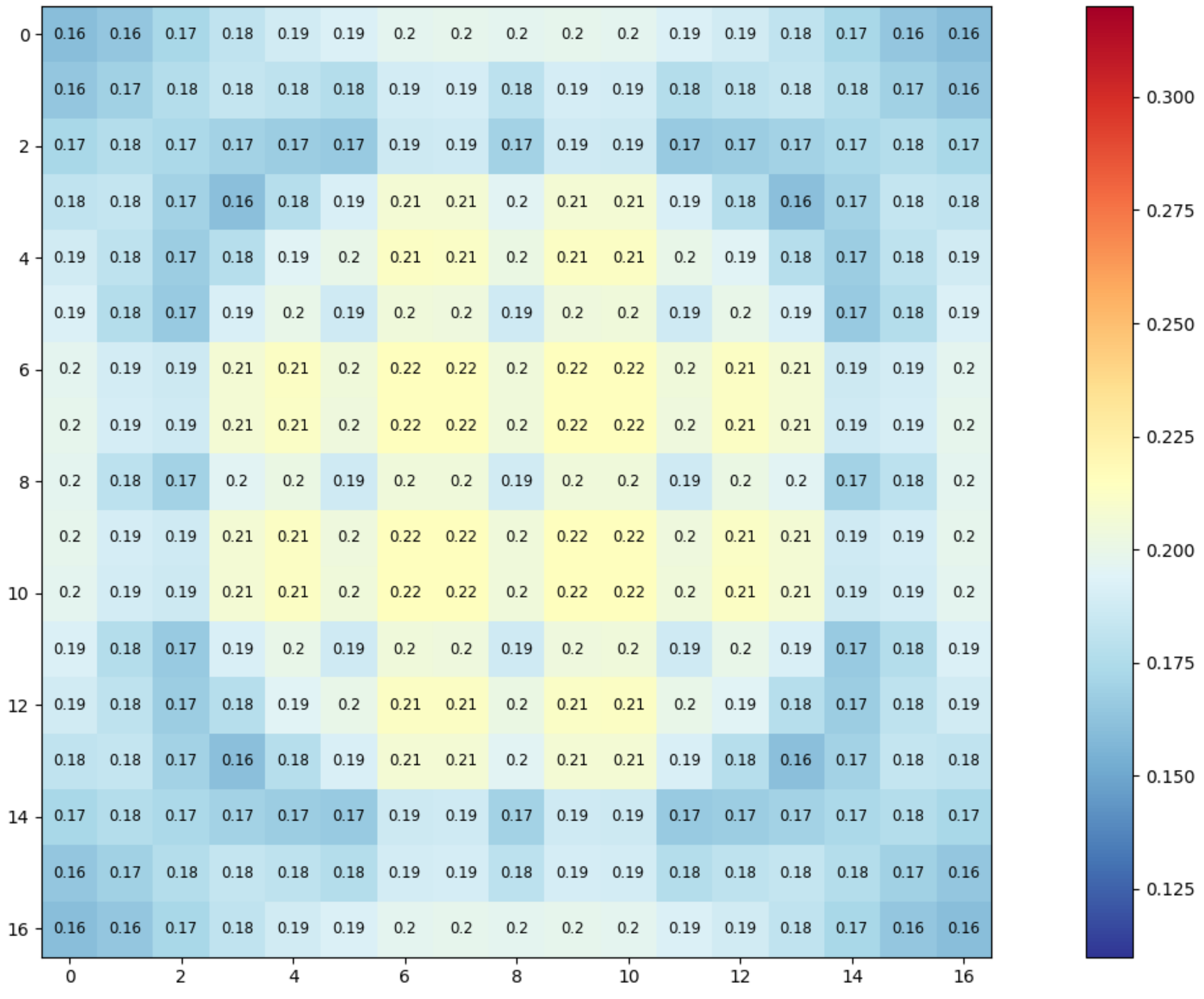

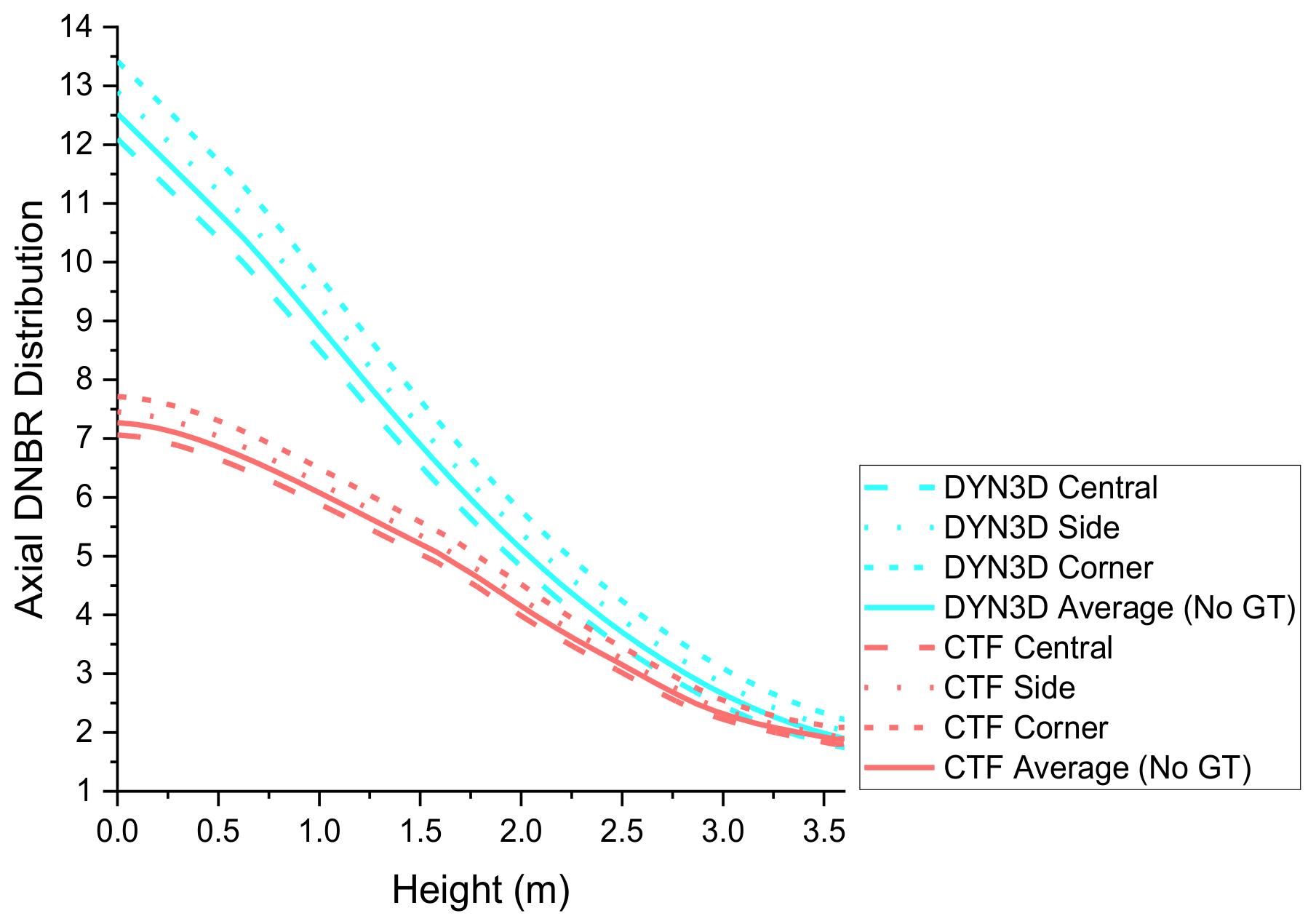
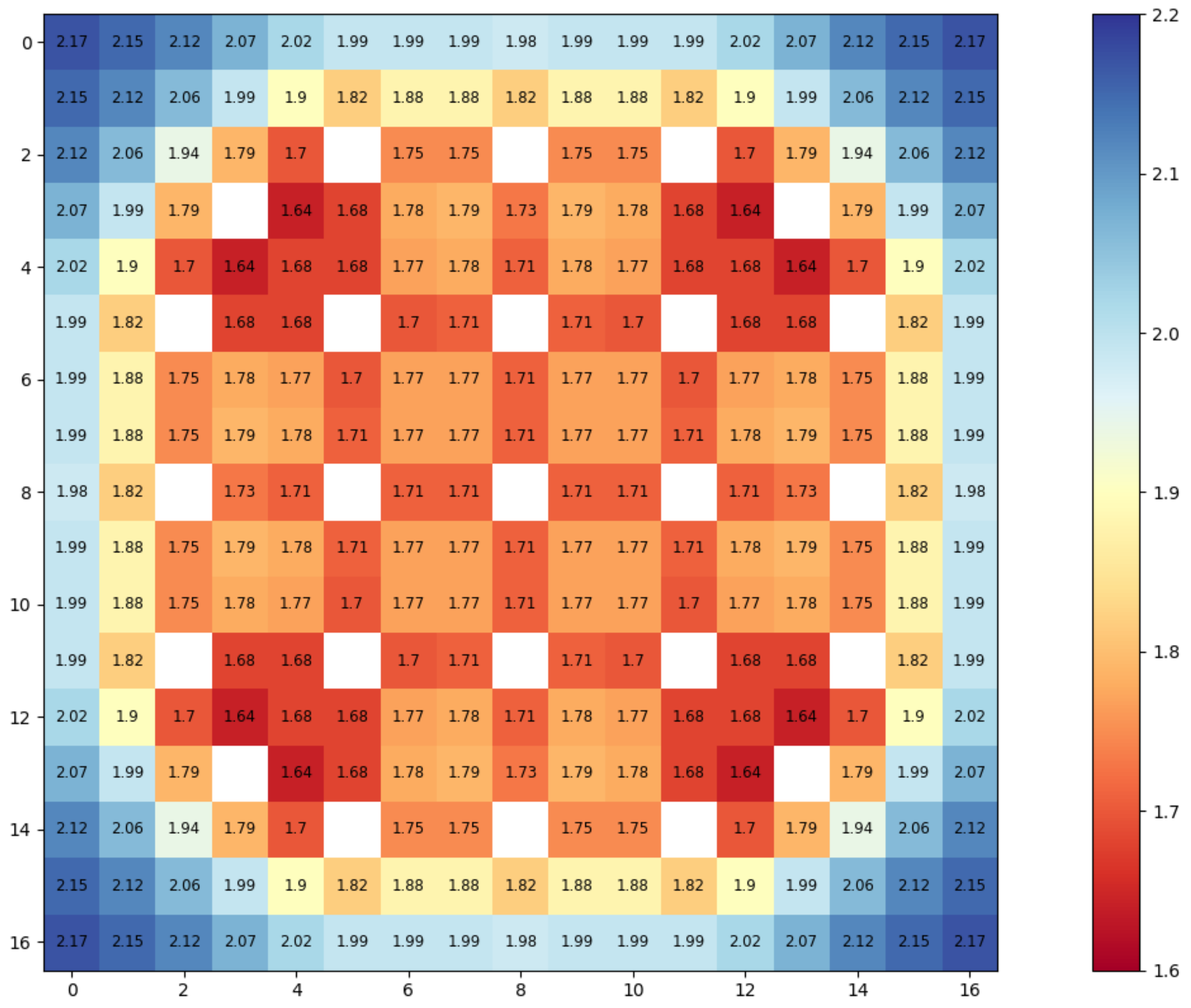
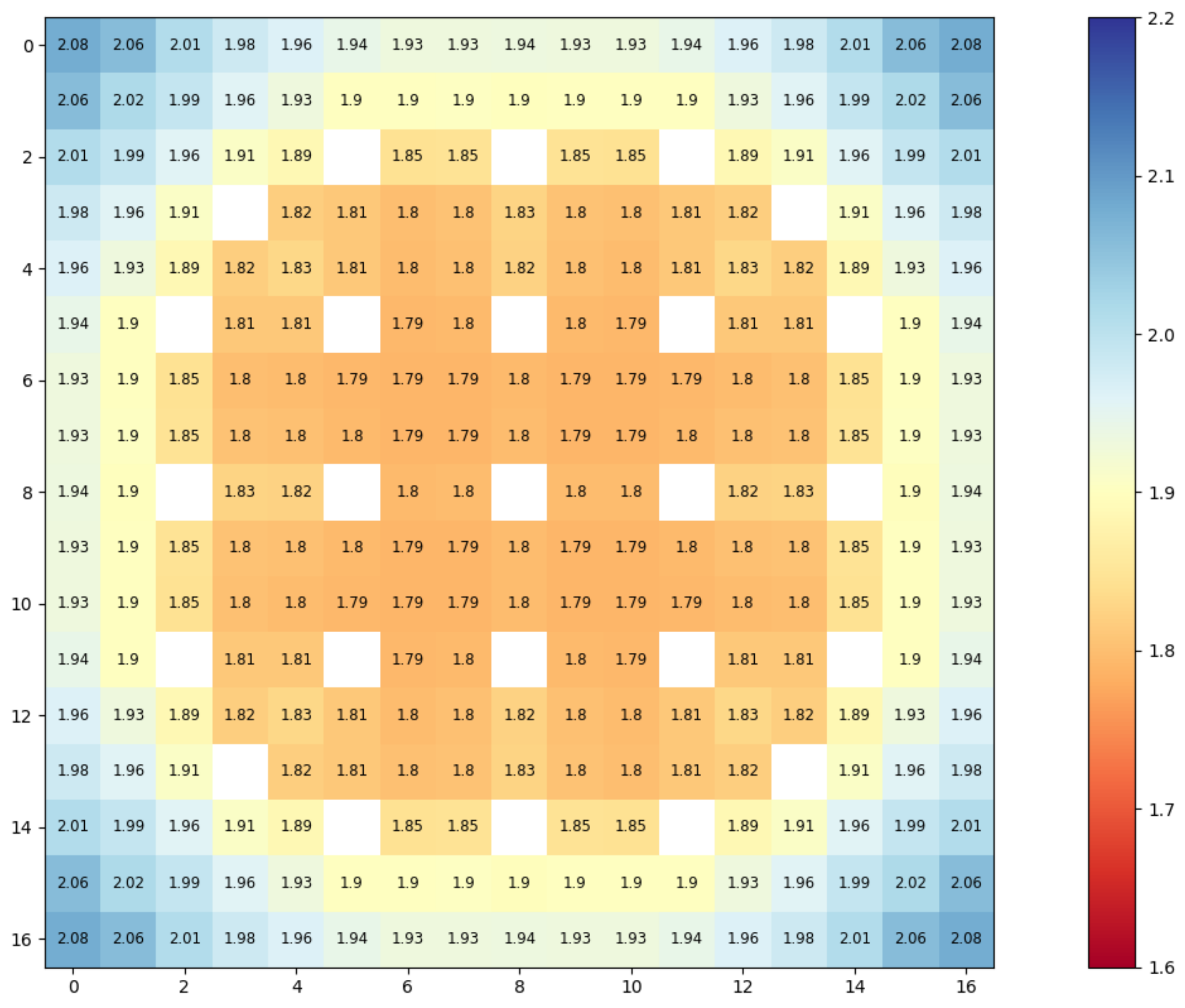
References
- World Nuclear Association. World Nuclear Power Performance Report; World Nuclear Association: London, UK, 2020; pp. 1–68. [Google Scholar]
- Institution of Electric Engineers. Nuclear Reactor Types; Institution of Electric Engineers: London, UK, 2005; pp. 1–15. ISBN 085-296-581-8. [Google Scholar]
- Health and Safety Executive. Public Report on the Generic Design Assesment of New Nuclear Reactor Designs; Health and Safety Executive: Merseyside, UK, 2007; pp. 1–38. [Google Scholar]
- UK Government Funding for Nuclear Innovation. Available online: https://www.gov.uk/guidance/funding-for-nuclear-innovation (accessed on 13 August 2021).
- EDF Nuclear New Build Projects. Available online: https://www.edfenergy.com/energy/nuclear-new-build-projects (accessed on 13 August 2021).
- Rolls Royce UK Small Modular Reactor: Pioneering Intelligent Power. Available online: https://www.rolls-royce.com/products-and-services/nuclear/small-modular-reactors.aspx#/ (accessed on 13 August 2021).
- Kyrieleis, A. Digital Reactor Design. In Proceedings of the Nuclear Virtual Engineering Capability, Warrington, UK, 22 October 2019; pp. 1–30. [Google Scholar]
- Lee, J.C.; Arbor, A. Nuclear Reactor Physics and Engineering; Sons, J.W., Ed.; Department of Nuclear Engineering, The University of Michigan: Ann Arbor, MI, USA, 2020. [Google Scholar]
- Duderstadt, J.J.; Hamilton, L.J. Nuclear Reactor Analysis; John Wiley & Sons: Hoboken, NJ, USA; Department of Nuclear Engineering, The University of Michigan: Ann Arbor, MI, USA, 1975. [Google Scholar]
- Rubén, J.; Perelló, B. Development of a Coupled Neutronics/Thermal-Hydraulics/Fuel Thermo-Mechanics Multiphysics Tool for Best-Estimate PWR Core Simulations; Karlsruher Institut für Technologie: Karlsruhe, Germany, 2020; pp. 1–172. [Google Scholar]
- Hooper, R.; Spotz, W.; Lorber, A.; Schmidt, R. A Multi-Physics Coupling Approach for Integrated Nuclear Reactor Safety Calculations. In Proceedings of the ANS Annual Meeting, Anaheim, CA, USA, 8–12 June 2008; pp. 1–26. [Google Scholar]
- Gaston, D.R.; Permann, C.J.; Peterson, J.W.; Andrew, E.; Slaughter, D.A.; Wang, Y.; Short, M.P.; Perez, D.M.; Tonks, M.R.; Ortensi, J.; et al. Physics-based multiscale coupling for full core nuclear reactor simulation. Ann. Nucl. Energy 2015, 84, 45–54. [Google Scholar] [CrossRef]
- Romano, P.K.; Forget, B. The OpenMC Monte Carlo Particle Transport Code. Ann. Nucl. Energy 2013, 51, 274–281. [Google Scholar] [CrossRef]
- Litskevich, D. Development of an Advanced Neutron Transport Solver for Zooming in DYN3D; Rheinisch-Westfälischen Technischen Hochschule Aachen: Aachen, Germany, 2017; pp. 1–148. [Google Scholar]
- Detkina, A.; Peakman, A.; Litskevich, D.; Liang, J. Evaluation of BWR Burnup Calculations Using Deterministic Lattice Codes SCALE-6.2, WIMS-10A and CASMO5. Energies 2020, 13, 2573. [Google Scholar] [CrossRef]
- Omar, M.R.; Karim, J.A.; Yoon, T.L. The development of a multigroup Monte Carlo code for TRIGA reactors. Nucl. Eng. Des. 2019, 342, 99–114. [Google Scholar] [CrossRef]
- Rohde, U.; Grundmann, U.; Kliem, S. DYN3D—Advanced Reactor Simulations in 3D; Nuclear Energy Review 2007/II; Forschung Dresden Rossendorf: Dresden, Germany, 2007; pp. 1–4. [Google Scholar]
- EDF UK PANTHER: PWR AGR Neutronics Thermal Hydraulics Evaluation Route. Available online: https://www.answerssoftwareservice.com/panther/ (accessed on 13 August 2021).
- Bahadir, T.; Lindahl, S.-O. Studsvik’s next generation nodal code SIMULATE-5. In Proceedings of the Advances in Nuclear Fuel Management IV, Hilton Head Island, SC, USA, 12–15 April 2009; pp. 1–12. [Google Scholar]
- Davies, S.; Rohde, U.; Litskevich, D.; Merk, B.; Bryce, P.; Levers, A.; Detkina, A.; Atkinson, S.; Ravindra, V. CTF and FLOCAL Thermal Hydraulics Validations and Verifications within a Multiscale and Multiphysics Software Development. Energies 2021, 14, 1220. [Google Scholar] [CrossRef]
- Imke, U.; Sanchez, V.H. Validation of the Subchannel Code SUBCHANFLOW Using the NUPEC PWR Tests (PSBT). Hindawi 2012, 12. [Google Scholar] [CrossRef]
- Bajorek, S.M.; Bernard, M.; Gingrich, C.; Hoxie, C.L.; Ireland, A.; Kelly, J.; Mahaffy, J.; Murray, C.; Spore, J.; Staudenmeier, J.; et al. Development, Validation and Assessment of the Trace Thermal Hydraulics System Code. In Proceedings of the 16th International Topical Meeting on Nuclear Reactor Thermal Hydraulics, Chicago, IL, USA, 30 August–4 September 2015; Volume 14, pp. 1–14. [Google Scholar]
- Rossiter, G. Development of the ENIGMA fuel performance code for whole core analysis and dry storage assessments. Nucl. Eng. Technol. 2011, 43, 489–498. [Google Scholar] [CrossRef]
- Magni, A.; Nevo, A.D.; Luzzi, L.; Rozzia, D.; Adorni, M.; Schubert, A.P. Van Uffelen Chapter 8—The TRANSURANUS fuel performance code. Woodhead Publ. 2021, 8, 161–205. [Google Scholar] [CrossRef]
- Aybar, H.Ş.; Ortego, P. A review of nuclear fuel performance codes. Prog. Nucl. Energy 2005, 46. [Google Scholar] [CrossRef]
- Patelli, E. COSSAN: A Multidisciplinary Software Suite for Uncertainty Quantification and Risk Management; Springer: Cham, Switzerland, 2015. [Google Scholar] [CrossRef]
- Chauliac, C.; Aragones, J.; Bestion, D.; Weiss, F.-P. NURESIM—A European simulation platform for nuclear reactor safety: Multi-scale and multi-physics calculations, sensitivity and uncertainty analysis. Nucl. Eng. Des. 2011, 241, 3416–3426. [Google Scholar] [CrossRef]
- Euratom NURESIM Nuclear Reactor Safety Simulation Platform. Available online: https://cordis.europa.eu/project/id/323263 (accessed on 13 August 2021).
- Szilard, R.; Zhang, H.; Kothe, B.D.; Turinsky, P. CASL The Consortium for Advanced Simulation of Light Water Reactors; INL/CON-11-22917; INL: Idaho Falls, ID, USA, 2011. [Google Scholar]
- US Department of Energy CASL Consortium for Advanced Simulation of Light Water Reactors. Available online: https://casl.gov/ (accessed on 13 August 2021).
- Bergeaud, V.; Tajchman, M. Application of the SALOME Software Architecture to Nuclear Reactor Research. Soc. Comput. Simul. Int. 2007, 2, 383–387. [Google Scholar] [CrossRef]
- Sanchez, R.; Mondot, J.; Stankovski, Z.; Cossic, A. APOLLO II: A User-Oriented, Portable, Modular Code for Multigroup Transport Assembly Calculations. Nucl. Sci. Eng. 1988, 100, 352–362. [Google Scholar] [CrossRef]
- Jimenez, G.; Herrero, J.J.; Cuervo, D.; Garcia-Herranz, N.; AShnert, C. Boron dilution benchmark using COBAYA3/FLICA4 coupled codes within the NURISP European Project. In Proceedings of the 38 Annual Meeting of Spanish Nuclear Society, Caceres, Spain, 17–19 October 2012; Volume 44094049. [Google Scholar]
- Rohde, U.; Pivovarov, V.A.; Matveev, Y.A. Studies on boiling water reactor design with reduced moderation and analysis of reactivity accidents using the code DYN3D-MG. Kerntechnik 2012, 77, 240–248. [Google Scholar] [CrossRef]
- Höhne, T.; Bieder, U.; Prasser, H.-M.; Kliem, S. Validation of Trio_U for Transient Accident Scenarios—Numerical Simulations Of A Rocom Buoyancy Driven Test Case. In Proceedings of the 12th International Conference on Nuclear Engineering (ICONE-12), Washington, DC, USA, 25–29 April 2004. [Google Scholar]
- Karlsruhe Institute of Technology Subchannel Flow. Available online: https://www.inr.kit.edu/english/1008.php (accessed on 13 August 2021).
- Toumi, I.; Bergeron, A.; Gallo, D.; Royer, E.D. Caruge FLICA-4: A three-dimensional two-phase flow computer code with advanced numerical methods for nuclear applications. Nucl. Eng. Des. 2000, 200, 139–155. [Google Scholar] [CrossRef]
- Guelfi, A.; Bestion, D.; Boucker, M.; Pascal, B.; Philippe, F.; Marc, G. NEPTUNE: A New Software Platform for Advanced Nuclear Thermal Hydraulics. Nucl Sci. Eng. 2007, 156, 281–324. [Google Scholar] [CrossRef]
- Labois, M.; Narayanan, C.; Lakehal, D. PTS Prediction Using (the) CMFD Code TransAT: The COSI Test Case. In Computational Fluid Dynamics (CFD) for Nuclear Reactor Safety Applications—Workshop Proceedings; NEA: Paris, France, 2012; p. 1231. [Google Scholar]
- Geffraye, G.; Antoni, O.; Farvacque, M.; Kadri, D.; Lavialle, G.; Rameau, B.; Ruby, A. CATHARE 2 V2.5_2: A single version for various applications. Nucl. Eng. Des. 2011, 241, 4456–4463. [Google Scholar] [CrossRef]
- Di Marcello, V.; Escalante, J.J.; Espinoza, V.S. Validation of the thermal-hydraulic system code ATHLET based on selected pressure drop and void fraction BFBT tests. Nucl. Eng. Des. 2015, 288, 183–194. [Google Scholar] [CrossRef]
- Georges, R.; Francois, J.; Francois, B.; Francois, L.; Jean-Marc, R. DRACCAR, a new 3D-thermal mechanical computer code to simulate LOCA transient on nuclear power plants Status of the development and the validation. In Proceedings of the International Congress on Advances in Nuclear Power Plants, Tokyo, Japan, 10–14 May 2009; p. 2572. [Google Scholar]
- Moal, A.; Georgenthum, V.; Marchand, O. SCANAIR: A transient fuel performance code: Part One: General modelling description. Nucl. Eng. Des. 2014, 280, 150–171. [Google Scholar] [CrossRef]
- Kulesza, J.A.; Franceschini, F.; Evans, T.M.; Gehin, J.C. Overview of the Consortium for the Advanced Simulation of Light Water Reactors (CASL). EPJ Web Conf. 2016, 106, 8. [Google Scholar] [CrossRef]
- Nuclear Energy Agency. ORIGEN-22, Isotope Generation and Depletion Code Matrix Exponential Method. Available online: https://www.oecd-nea.org/tools/abstract/detail/ccc-0371 (accessed on 13 August 2021).
- Rearden, B.T.; Anderson, J.M. SCALE Code System 6.2.1. Int. At. Energy Agency 2016, 48, 1–2712. [Google Scholar]
- Kochunas, B.; Jabaay, D.; Downar, T.; Collins, B.S.; Stimpson, S.G.; Godfrey, A.T. Validation and Application of the 3D Neutron Transport Code MPACT within CASL VERA-CS. In Proceedings of the Sixteenth International Topical Meeting on Nuclear Reactor Thermal Hydraulics NURETH-16, Chicago, IL, USA, 30 August–4 September 2015; pp. 1–14. [Google Scholar]
- Hamilton, S.P.; Evans, M.E.; Davidson, G.G. Hot Zero Power Reactor Calculations Using the Insilico Code; Elsevier: Amsterdam, The Netherlands, 2016; Volume 314, pp. 700–711. [Google Scholar] [CrossRef]
- Pandya, T.M.; Johnson, S.R.; Evans, T.M.; Gregory, G. Implementation, Capabilities, and Benchmarking of Shift, a Massively Parallel Monte Carlo Radiation Transport Code; Elsevier: Amsterdam, The Netherlands, 2015; Volume 308, pp. 239–272. [Google Scholar] [CrossRef]
- Zhao, X.; Wysocki, A.J.; Shirvan, K.; Salko, R.K. Assessment of the Subchannel Code CTF for Single-and Two-Phase Flows. Nucl. Technol. 2019, 205, 338–351. [Google Scholar] [CrossRef]
- Christon, M.A.; International, C.S.; Bakosi, J.; Lowrie, R.B.; Pritchett-sheats, L. Hydra-TH: A Thermal-Hydraulics Code for Nuclear Reactor Applications. In Proceedings of the Fifteenth International Topical Meeting on Nuclear Reactor Thermal Hydraulics NURETH-15, Pisa, Italy, 12–17 May 2013; pp. 1–33. [Google Scholar]
- Hou, X.; Sun, Z.; Lei, W. Capability of RELAP5 code to simulate the thermal-hydraulic characteristics of open natural circulation. Ann. Nucl. Energy 2017, 109, 612–625. [Google Scholar] [CrossRef]
- Merk, B.; Bankhead, M.; Litskevich, D.; Gregg, R.; Peakman, A.; Shearer, C. On a Roadmap for Future Industrial Nuclear Reactor Core Simulation in the U.K. to Support the Nuclear Renaissance. Energies 2018, 11, 3509. [Google Scholar] [CrossRef]
- Labarile, A.; Olmo, N.; Miró, R.; Barrachina, T.; Verd, G. Comparison of SERPENT and SCALE methodology for LWRs transport calculations and additionally uncertainty analysis for cross-section perturbation with SAMPLER module. EPJ Nucl. Sci. Technol. 2016, 11, 1–14. [Google Scholar] [CrossRef][Green Version]
- Litskevich, D.; Atkinson, S.; Davies, S. Verification of the current coupling collision probability method with orthogonal flux expansion for the assembly calculations. Prog. Nucl. Energy 2020, 130. [Google Scholar] [CrossRef]
- Jackson, P.; Turnbull, J. Enigma Fuel Performance Code. Nucl. Energy 1990, 21, 107–114. [Google Scholar]
- Torres, A.G.; Espinoza, V.S.; Imke, U.; Juan, R.M. Pin Level Neutronic—Thermalhydraulic Two-Way-Coupling Using DYN3D-SP3 And SUBCHANFLOW. In Proceedings of the International Conference on Mathematics and Computational Methods Applied to Nuclear Science and Engineering, Rio de Janeiro, Brazil, 8–12 May 2011; pp. 1–20. [Google Scholar]
- Atkinson, S.; Detkina, A.; Litskevich, D.; Merk, B. A Comparison of Advanced Boiling Water Reactor Simulations Between Serpent/CTF and Polaris/DYN3D: Steady State Operational Characteristics and Burnup Evolution. Energies 2021, 14, 40. [Google Scholar] [CrossRef]
- Zimin, V.G.; Nikonov, S.P. Coupling of the Neutron Diffusion Code SKETCH-N and the Thermal-Hydraulics System Code ATHLET for VVER-1000 Calculations. In Proceedings of the 28th Symposium of AER on VVER Reactor Physics and Reactor Safety, Olomouc, Czech Republic, 8–12 October 2018; pp. 1–20. [Google Scholar]
- Rohde, U.; Kliem, S.; Grundmann, U.; Baier, S.; Bilodid, Y.; Duerigen, S.; Fridman, E.; Gommlich, A.; Grahn, A.; Holt, L.; et al. The reactor dynamics code DYN3D—Models, validation and applications. Prog. Nucl. Energy 2016, 89, 140. [Google Scholar] [CrossRef]
- Grundmann, U.; Rohde, U. The Code DYN3D/M2 for the Calculation of Rectivity Initiated Transients in Light Water Reactors with Hexagonal Fuel Elements—Code Manual and Input Data Description; Helmholtz-Zentrum Dresden-Rossendorf: Dresden, Germany, 2012. [Google Scholar]
- Salko, R., Jr.; Avramova, M.; Wysocki, A.; Hu, J.; Toptan, A.; Porter, N.; Blyth, T.S. CTF 4.0 Theory Manual; ORNL: Oak Ridge, TN, USA, 2019. [Google Scholar] [CrossRef]
- Salko, R., Jr.; Avramova, M.; Wysocki, A.; Hu, J.; Toptan, A.; Porter, N.; Blyth, T.S. CTF 4.0 User Manual; ORNL: Oak Ridge, TN, USA, 2020. [Google Scholar] [CrossRef]
- Cho, N.Z. Benchmark Problem 1A: MOX Fuel-Loaded Small PWR Core (MOX Fuel with Zoning); KAIST/NurapT: Daejeon, Korea, 2000. [Google Scholar]
- Rohde, U.; Grundmann, U. DYNamical 3 Dimensional. Available online: https://www.hzdr.de/db/Cms?pOid=11771&pNid=542 (accessed on 13 August 2021).
- Avramova, M.; Toptan, A.; Porter, N. Coolant Boiling in Rod Arrays Two Fluid. Available online: https://www.ne.ncsu.edu/rdfmg/cobra-tf/ (accessed on 13 August 2021).
- Osmachkin, V.; Borisov, V. The hydraulic resistance of fuel rod bundles in a boiling water flow. IAEA 1970, 2, 24. [Google Scholar]
- McAdams, W. Heat Transmission; Pub, K., Ed.; McGraw-Hill: New York, NY, USA, 1985; ISBN 0898748763. [Google Scholar]
- Poljanin, L.; Ibragimov, M. Teploobmen v jadernikh reaktorakh. In Ehnergoizdat; USSR: Moscow, Russia, 1982; p. 296. [Google Scholar]
- Thorn, B.J.R.S.; Walkert, W.M.; Fallon, T.A.; Reising, G.F.S. Boiling in Subcooled Water During Flow up Heated Tubes or Annuli. Mater. Sci. 1965, 180, 226–246. [Google Scholar] [CrossRef]
- Bezrukov, Y.; Astakhov, V. Experimental investigation and static analysis of data on crisis of heat exchange in beams of rods for WWER reactors. Teploehnergetika 1976, 8, 80–82. [Google Scholar]
- Tong, L.S. Prediction of Departure from Nucleate Boiling for an Axially Non-Uniform Heat Flux Distribution. J. Nucl. Energy 1967, 21, 221–248. [Google Scholar] [CrossRef]
- Tong, L. Boiling Crisis and Critical Heat Flux; IAEA: Pittsburgh, PA, USA, 1972. [Google Scholar]
- Rogers, J.T.; Rosehart, R.G. Mixing by Turbulent Interchange in Fuel Bundles. In Correlations and Interfaces; ASME: New York, NY, USA, 1972. [Google Scholar]

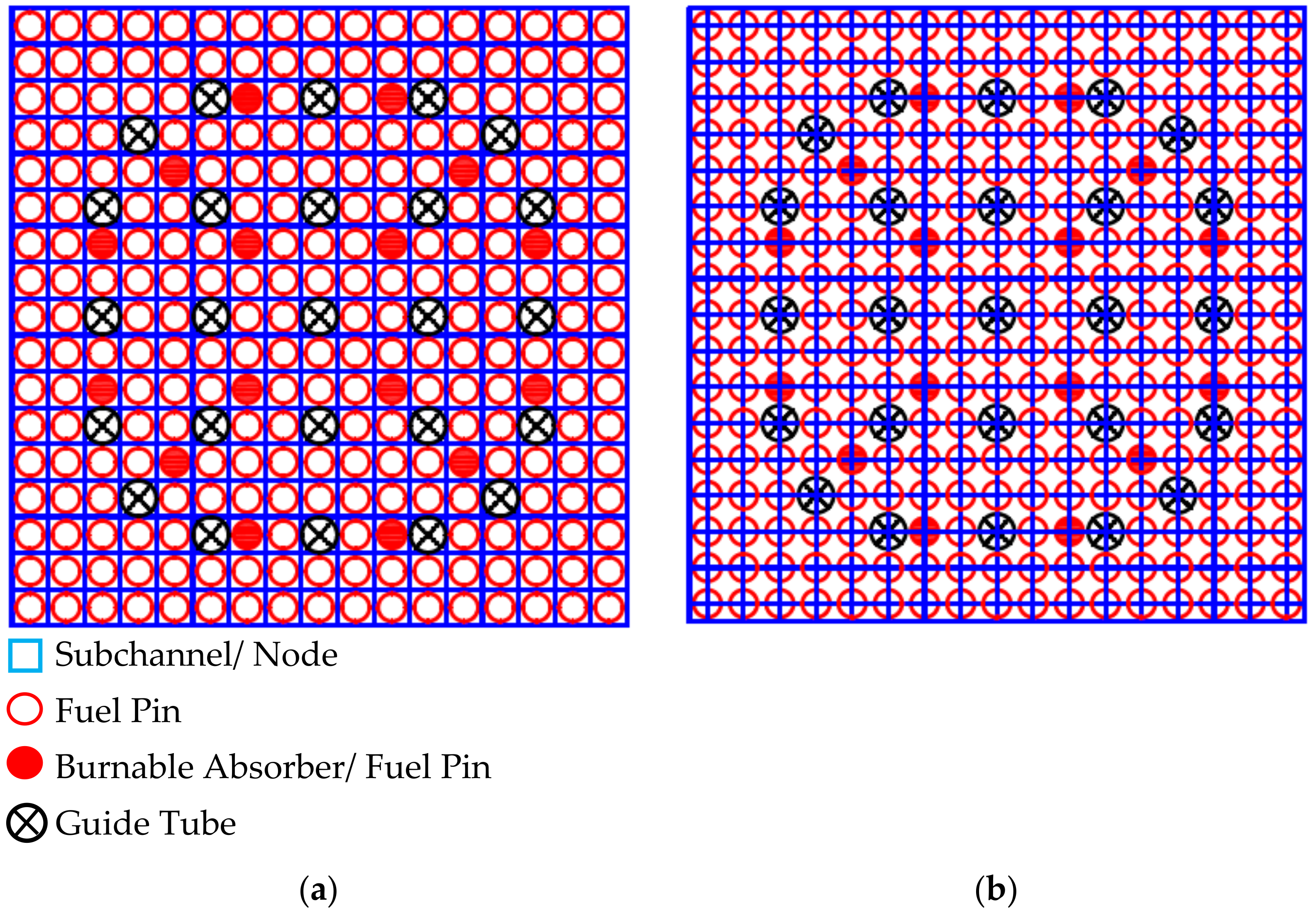
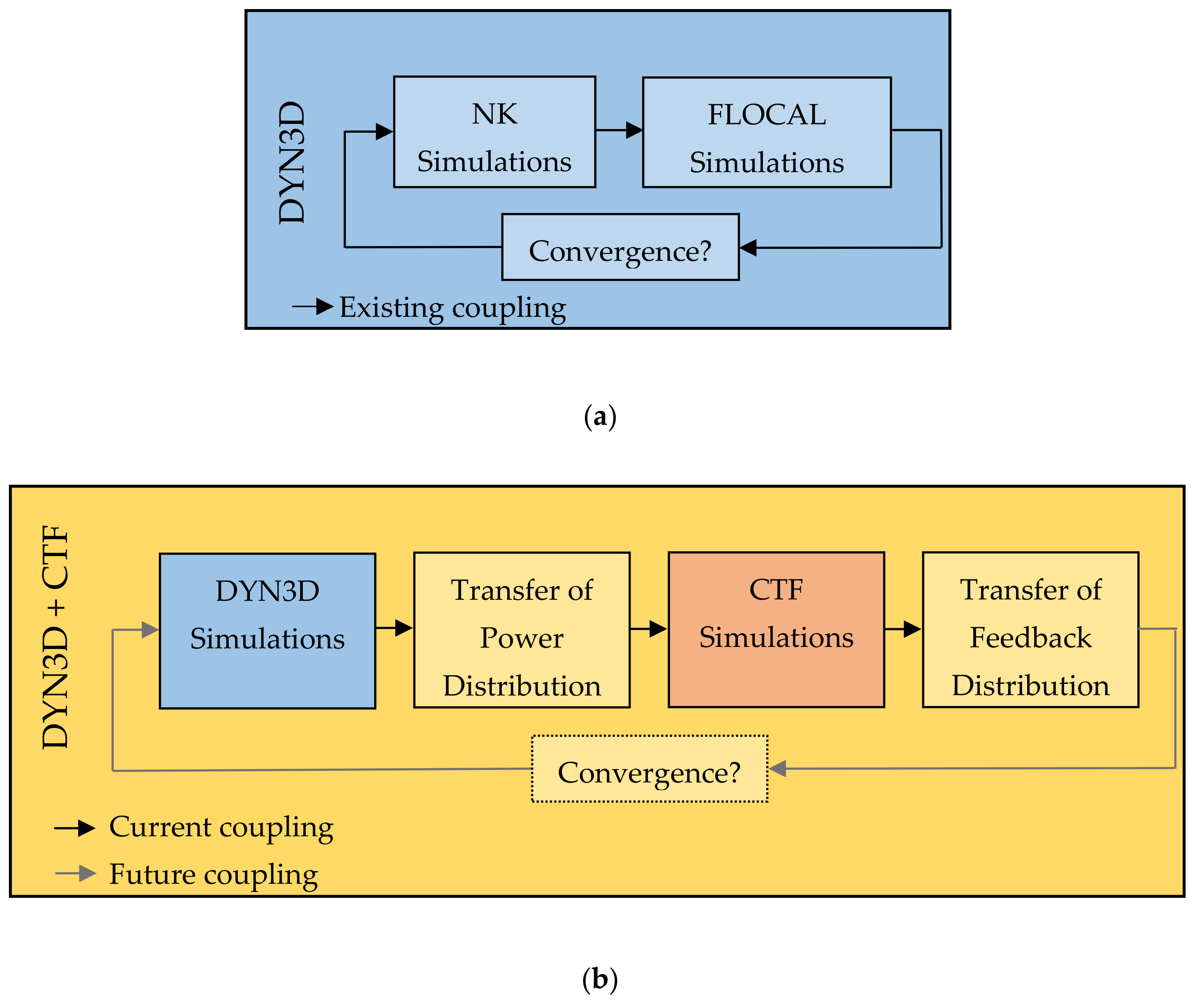
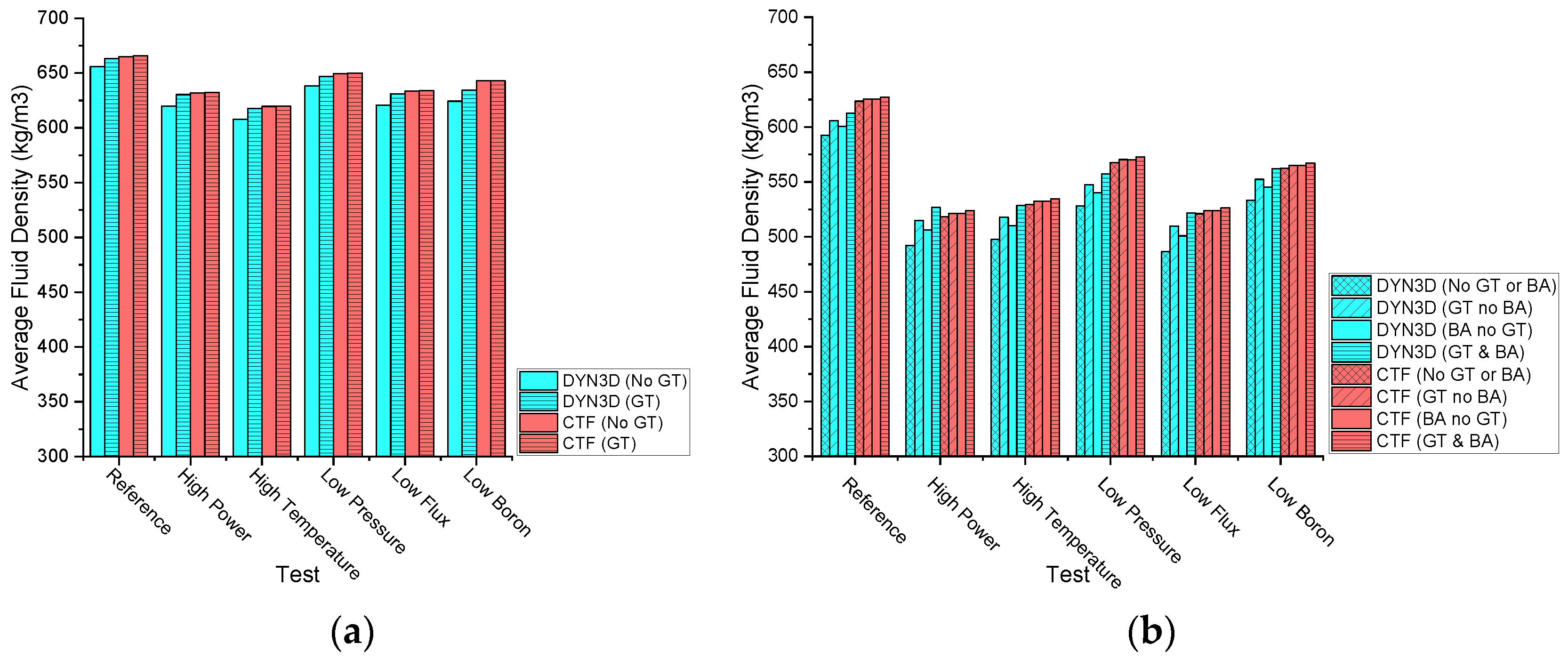

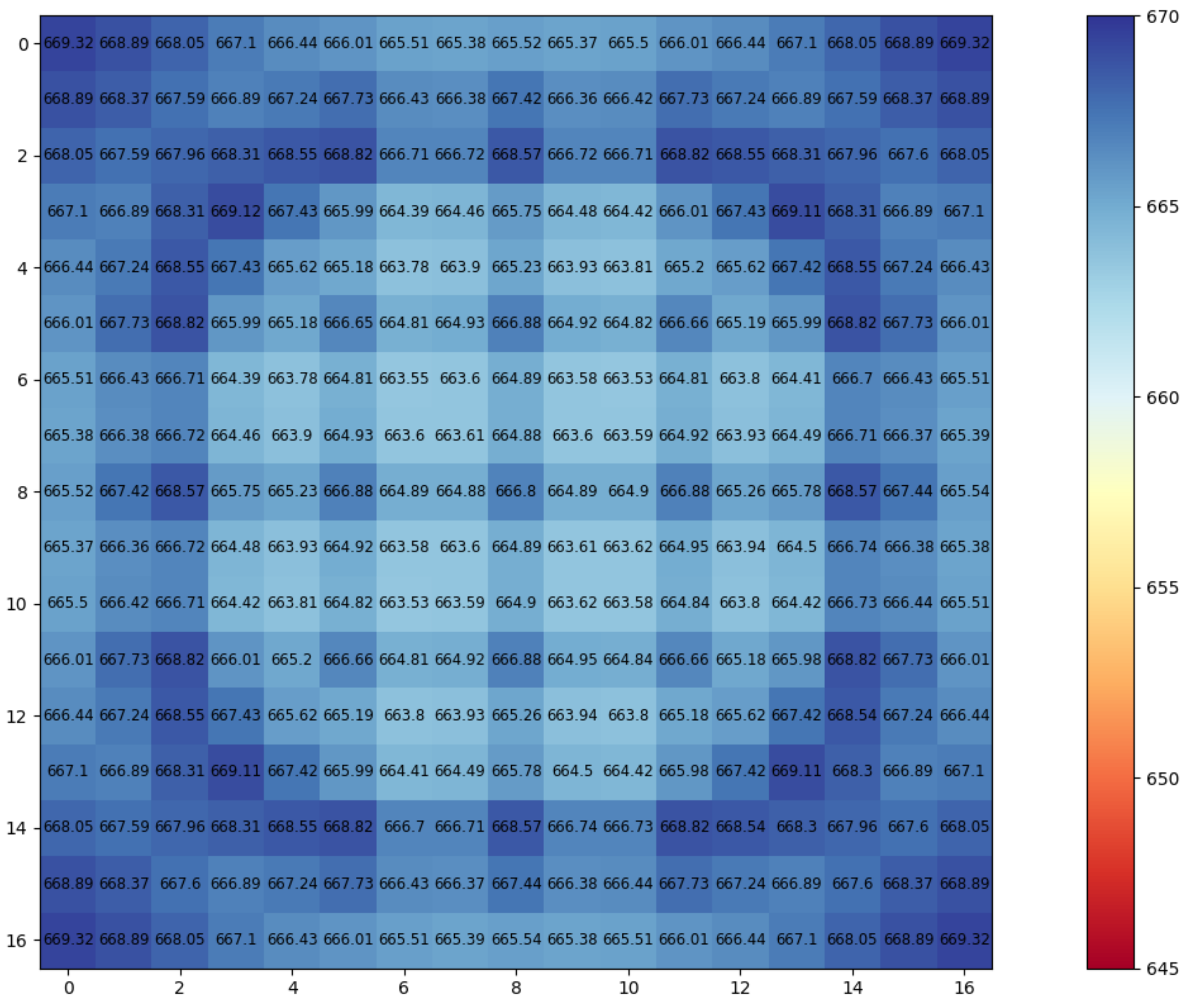


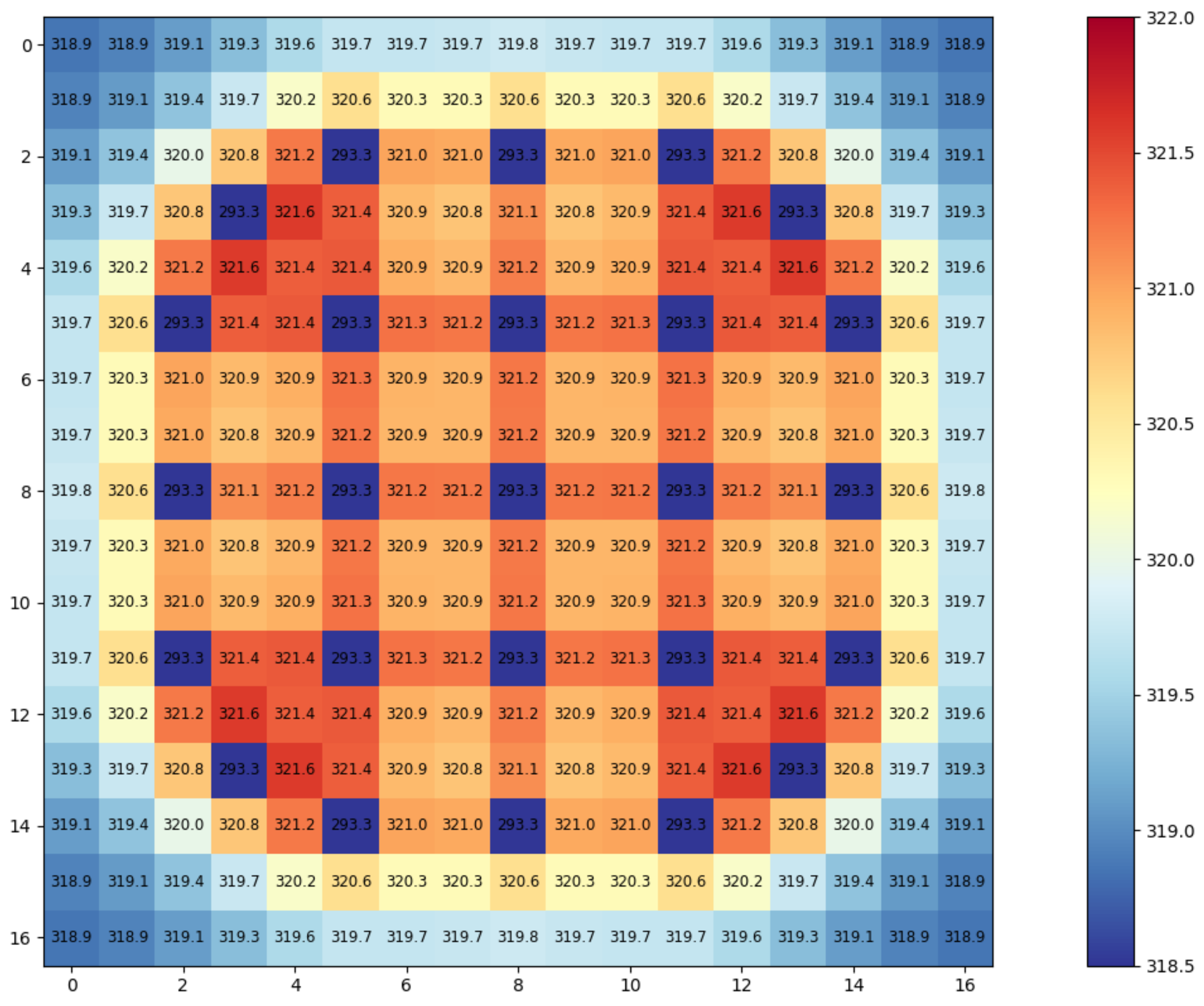
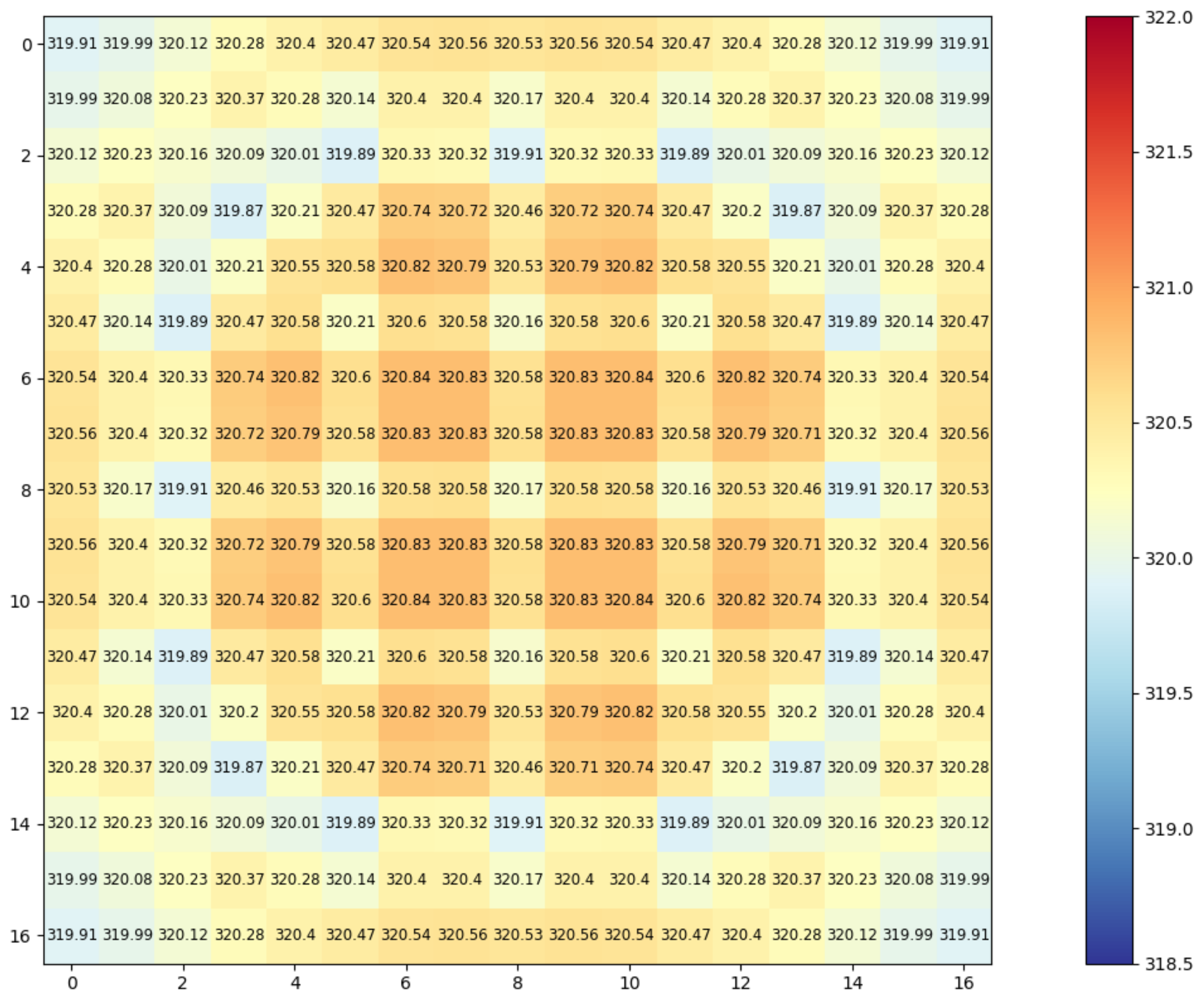
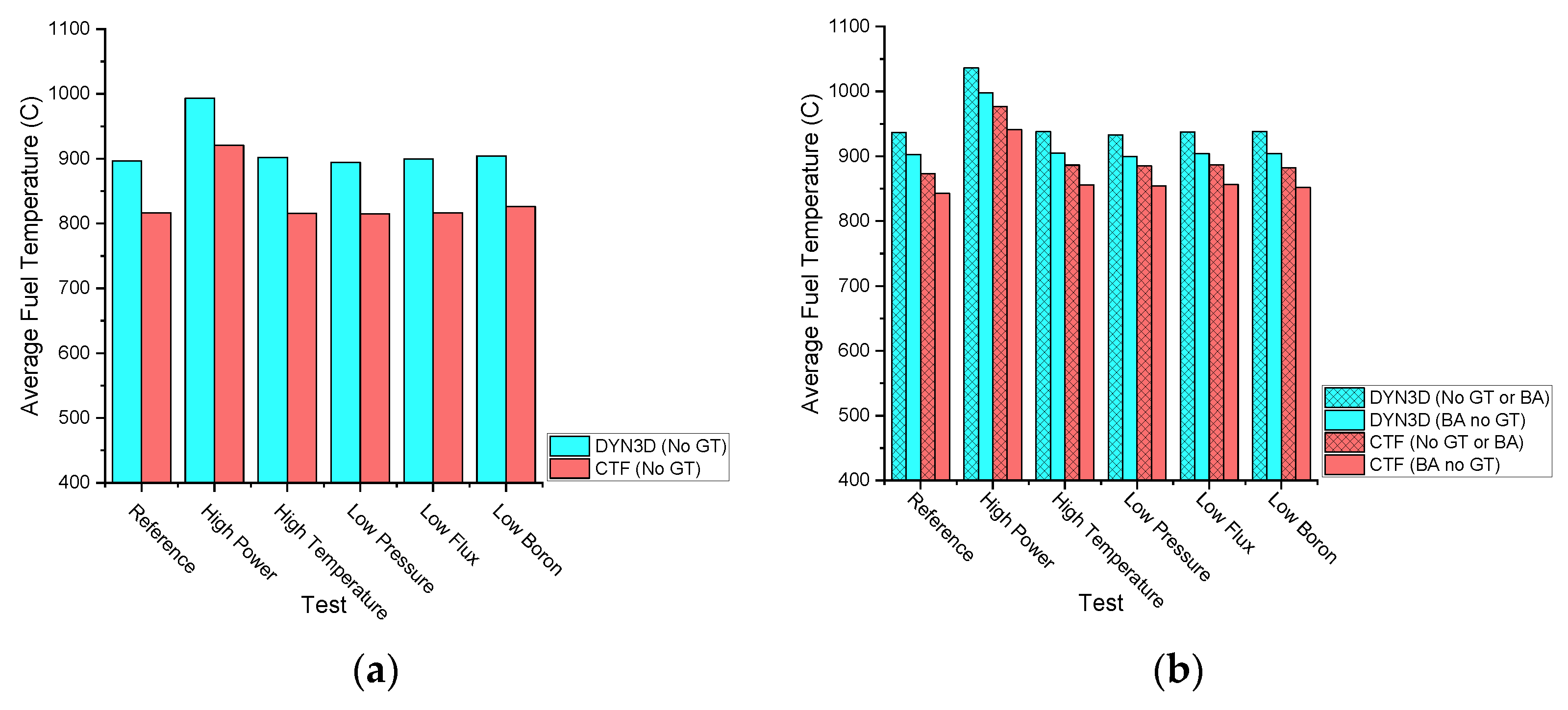
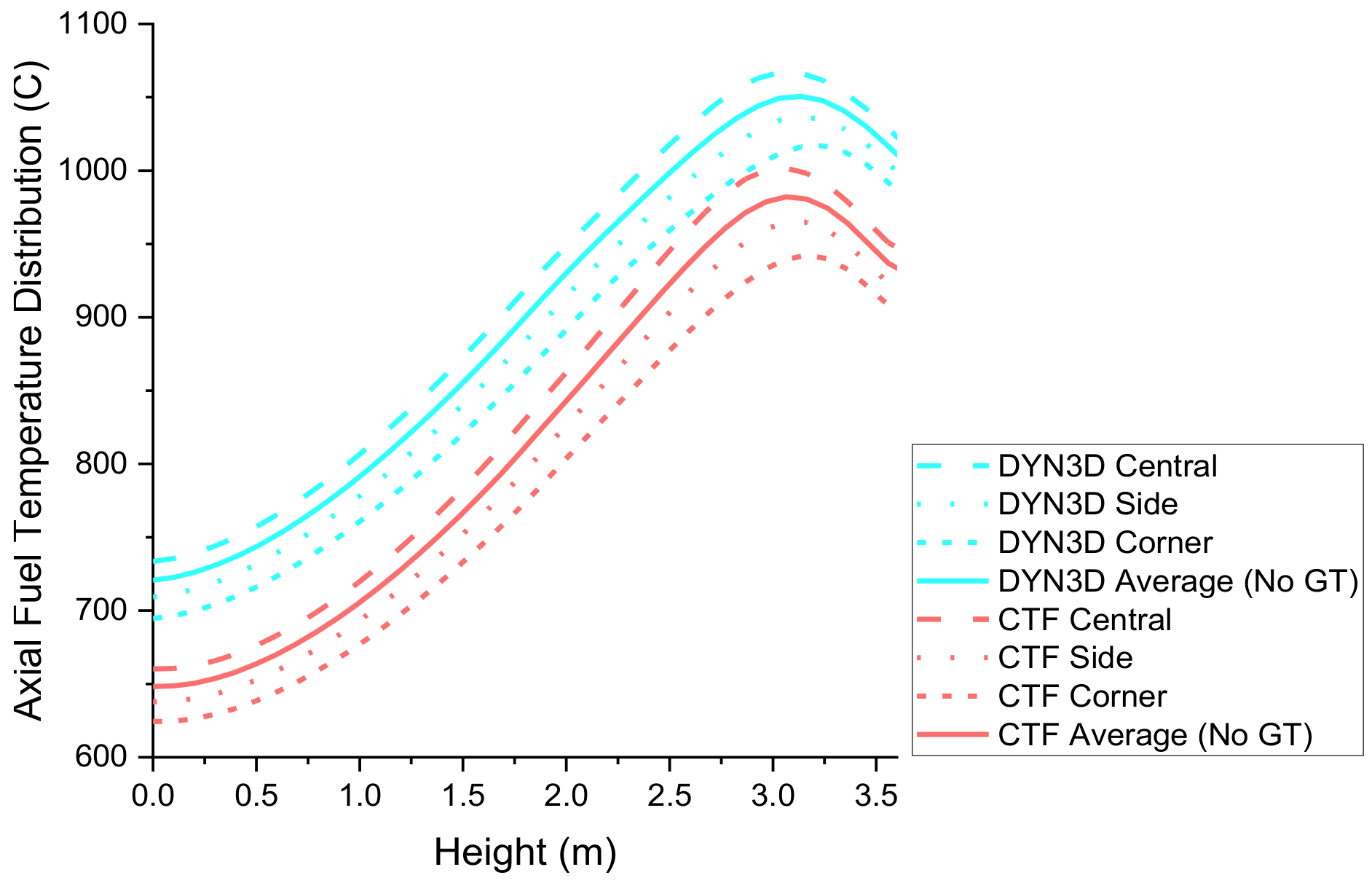
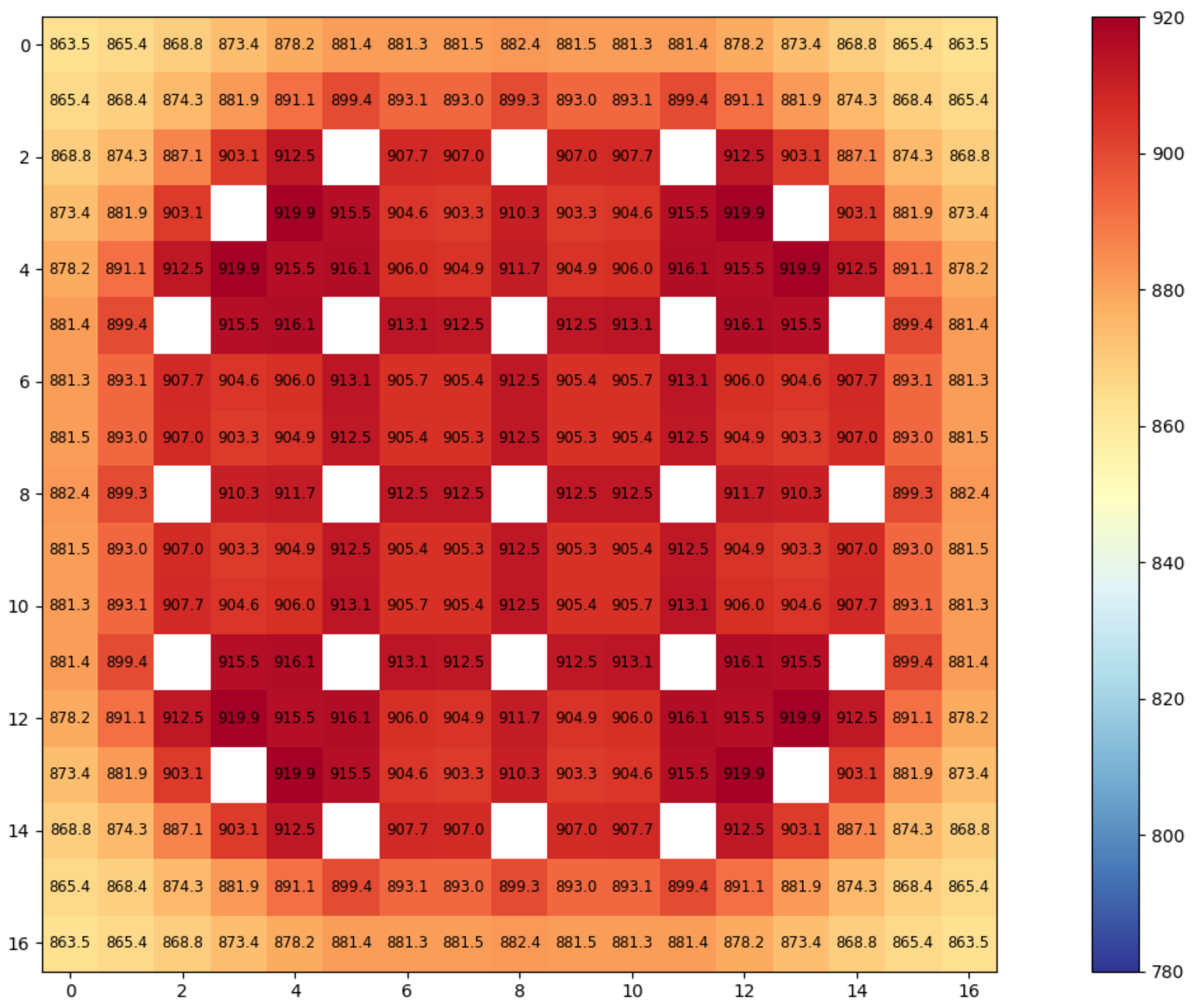
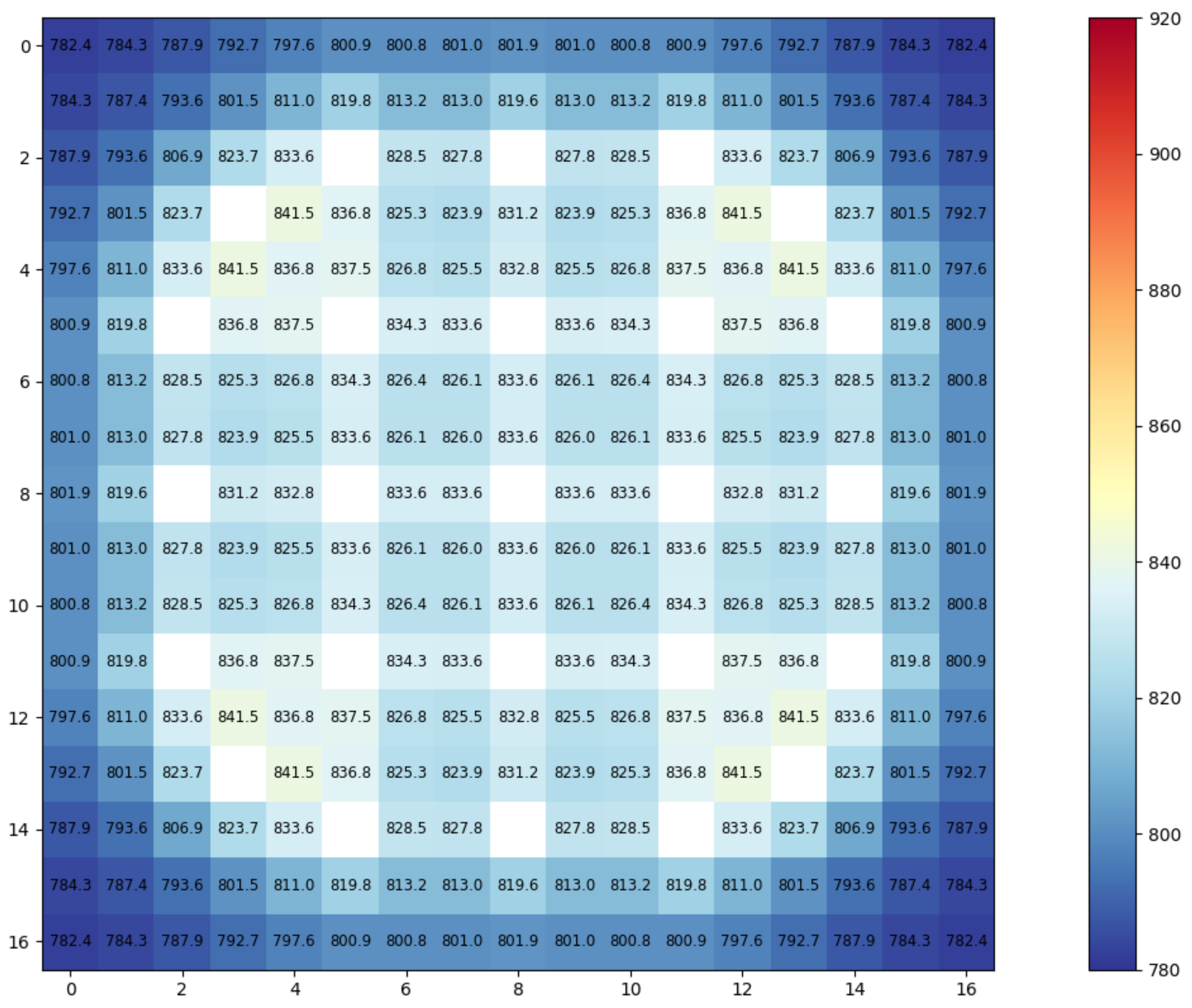
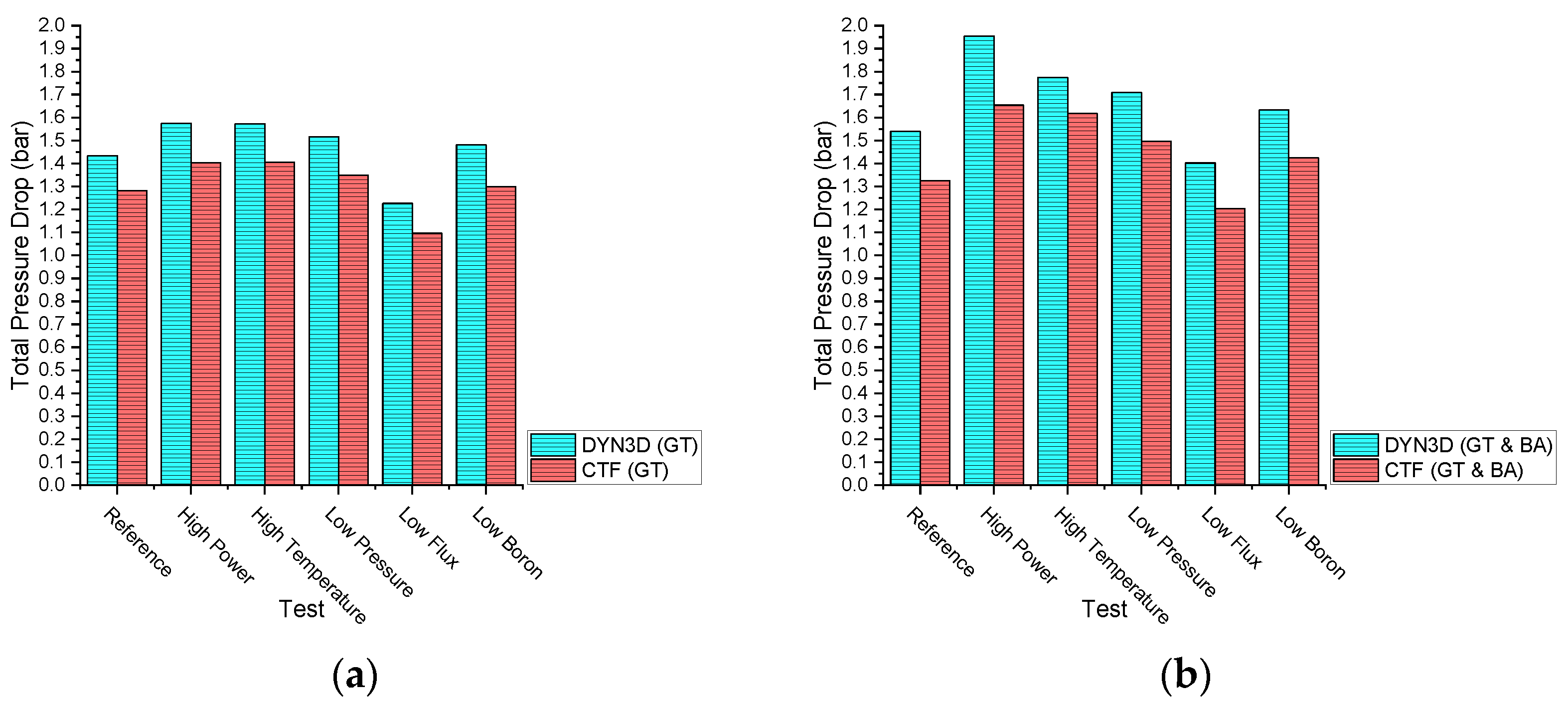
 | ||
| Type | UOX-2 (CR) 17 × 17 Assembly | UOX-2 (BA16) 17 × 17 Assembly |
| Number of Fuel Pins | 264 | 248 |
| Number of Burnable Absorber Pins | 0 | 16 |
| Number of Guide Tubes | 25 | 25 |
| Channel Width (m) | 0.2142 | 0.2142 |
| Cell Width (m) | 0.0126 | 0.0126 |
| Axial Length (Active) (m) | 3.658 | 3.658 |
 | ||
| Type | Fuel/Burnable Absorber Pin | |
| Clad Diameter (m) | 0.0095 | |
| Clad Thickness (m) | 0.00057 | |
| Gap Thickness (m) | 0.000085 | |
| Fuel Pin Diameter (m) | 0.0082 | |
 | ||
| Type | Guide Tube | |
| Guide Tube Diameter (m) | 0.01224 | |
| Clad Thickness (m) | 0.000405 | |
| Fuel Pin Composition | UO2 (3.3% 235U, 96.7% 238U) |
| Burnable Absorber Pin Composition | UO2 (0.711% 235U, 90.289% 238U) + Gd2O3 (9.0%) |
| Clad Composition | Zircalloy (97.91% Zr, 1.59% Sn, 0.5% Fe) |
| Energy Groups (eV) | Group 0 ≡ (0.62506, 2231300) Group 1 ≡ (0.000014, 0.62506) |
| Fuel Density (kg/m3) | 10040 |
| Fuel Specific Heat (J/kg K) | |
| Fuel Thermal Conductivity (W/m K) | |
| Clad Density (kg/m3) | 6400 |
| Clad Specific Heat (J/kg K) | |
| Clad Thermal Conductivity (W/m K) | |
| Gap Gas | He |
| Gap Heat Conductance (kJ/m2 K) | 5678 |
| Pressure Loss Coefficient | 0.30 |
| Spacer Grids Location (m) | Uniform |
| Case | Outlet Pressure (Bar) | Power (MW) | Mass Flux (kg/m2 s) | Inlet Temperature (C) | Boric Acid Concentration (ppm) |
|---|---|---|---|---|---|
| Reference | 155 | 25.960 | 2889.33 | 293.33 | 2250 |
| High Power | 155 | 30.287 | 2889.33 | 293.33 | 2250 |
| High Temperature | 155 | 25.960 | 2889.33 | 303.33 | 2250 |
| Low Pressure | 145 | 25.960 | 2889.33 | 293.33 | 2250 |
| Low Flux | 155 | 25.960 | 2476.58 | 293.33 | 2250 |
| Low Boron | 155 | 25.960 | 2889.33 | 293.33 | 1125 |
Publisher’s Note: MDPI stays neutral with regard to jurisdictional claims in published maps and institutional affiliations. |
© 2021 by the authors. Licensee MDPI, Basel, Switzerland. This article is an open access article distributed under the terms and conditions of the Creative Commons Attribution (CC BY) license (https://creativecommons.org/licenses/by/4.0/).
Share and Cite
Davies, S.; Litskevich, D.; Rohde, U.; Detkina, A.; Merk, B.; Bryce, P.; Levers, A.; Ravindra, V. DYN3D and CTF Coupling within a Multiscale and Multiphysics Software Development (Part I). Energies 2021, 14, 5060. https://doi.org/10.3390/en14165060
Davies S, Litskevich D, Rohde U, Detkina A, Merk B, Bryce P, Levers A, Ravindra V. DYN3D and CTF Coupling within a Multiscale and Multiphysics Software Development (Part I). Energies. 2021; 14(16):5060. https://doi.org/10.3390/en14165060
Chicago/Turabian StyleDavies, Sebastian, Dzianis Litskevich, Ulrich Rohde, Anna Detkina, Bruno Merk, Paul Bryce, Andrew Levers, and Venkata Ravindra. 2021. "DYN3D and CTF Coupling within a Multiscale and Multiphysics Software Development (Part I)" Energies 14, no. 16: 5060. https://doi.org/10.3390/en14165060
APA StyleDavies, S., Litskevich, D., Rohde, U., Detkina, A., Merk, B., Bryce, P., Levers, A., & Ravindra, V. (2021). DYN3D and CTF Coupling within a Multiscale and Multiphysics Software Development (Part I). Energies, 14(16), 5060. https://doi.org/10.3390/en14165060







